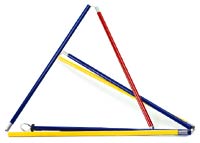Outfitter: Backcountry, Carry-in Items

Backcountry
skiing takes you away from the ski area-the crowds, the lift-ticket cashiers-but it also takes you away from the ski patrol. So self-sufficiency is paramount. In addition to the technical clothing, sunglasses, and sunscreen you use inbounds, always take the following backcountry essentials when you head out of bounds:
PACK When choosing a pack, think small; the smaller the pack, the less unneeded gear you’ll lug. And make sure it fits: An ill-fitting pack is an unbalanced pack-not good when maneuvering in steep couloirs.
Ortovox’s Cumulus 40 ($159) is a good size (2,500 cubic inches) for day tours. Its sophisticated strap system allows you to adjust the pack’s torso length and width to accommodate extra layers of clothing. Specific compartments hold Ortovox’s avalanche-safety system: a shovel ($64), avalanche probe ($59), and bivouac sack ($69).
AVALANCHE BEACON Always carry a beacon, learn to use it intuitively, and make sure your skiing partners do the same.
Beacons locate each other through signals that they emit and receive. If someone gets caught in a slide, searchers switch their beacons from “send” to “receive” and use them to home in on the buried beacon (and person). Analog beacons like the Ortovox F1 ($250) emit an audio signal; digital beacons, such as Backcountry Access’ Tracker DTS ($300), use audio and also incorporate directional readings.
AVALANCHE PROBES These eight-to 10-foot-long collapsible poles are an essential tool for finding someone buried deep in the snow.
SHOVEL Get one big and sturdy enough to quickly dig out a buried friend. Attach it to your pack and keep it there.
FIRST-AID KIT Buy one or make your own. Don’t forget moleskin, aspirin or ibuprofen, bandages, and scissors or a Swiss Army knife.
TOPO MAP AND COMPASS At least one person in your group should know how to use these together. Keep the map in a plastic bag.
WATER This should be a no-brainer. Take a water filter if you plan to be out longer than a day. Consider an insulated hydration system like CamelBak’s SnoBowl ($53).
FOOD Think like a backpacker: lightweight, easy to eat, lots of carbs and protein.
CELLULAR PHONES Don’t cringe; it’s not for calling Charles Schwab. Cell phones do offer some security in the backcountry. But mountains have a way of interfering with cells, so you still have to be self-reliant.
OTHER ITEMS Ski crampons, ice axes, and self-arrest pole grips are necessary for crossing glaciers and treacherous terrain. If you’re unfamiliar with their use, you probably shouldn’t be there without a professional guide. In fact, if you’re a backcountry beginner or don’t know an area, hire a guide. Mountaineering shops can put you in touch with one.
Info:
BACKCOUNTRY ACCESS:
www.bcaccess.com
CAMELBAK:
www.camelbak.com
ORTOVOX:
www.ortovox.com